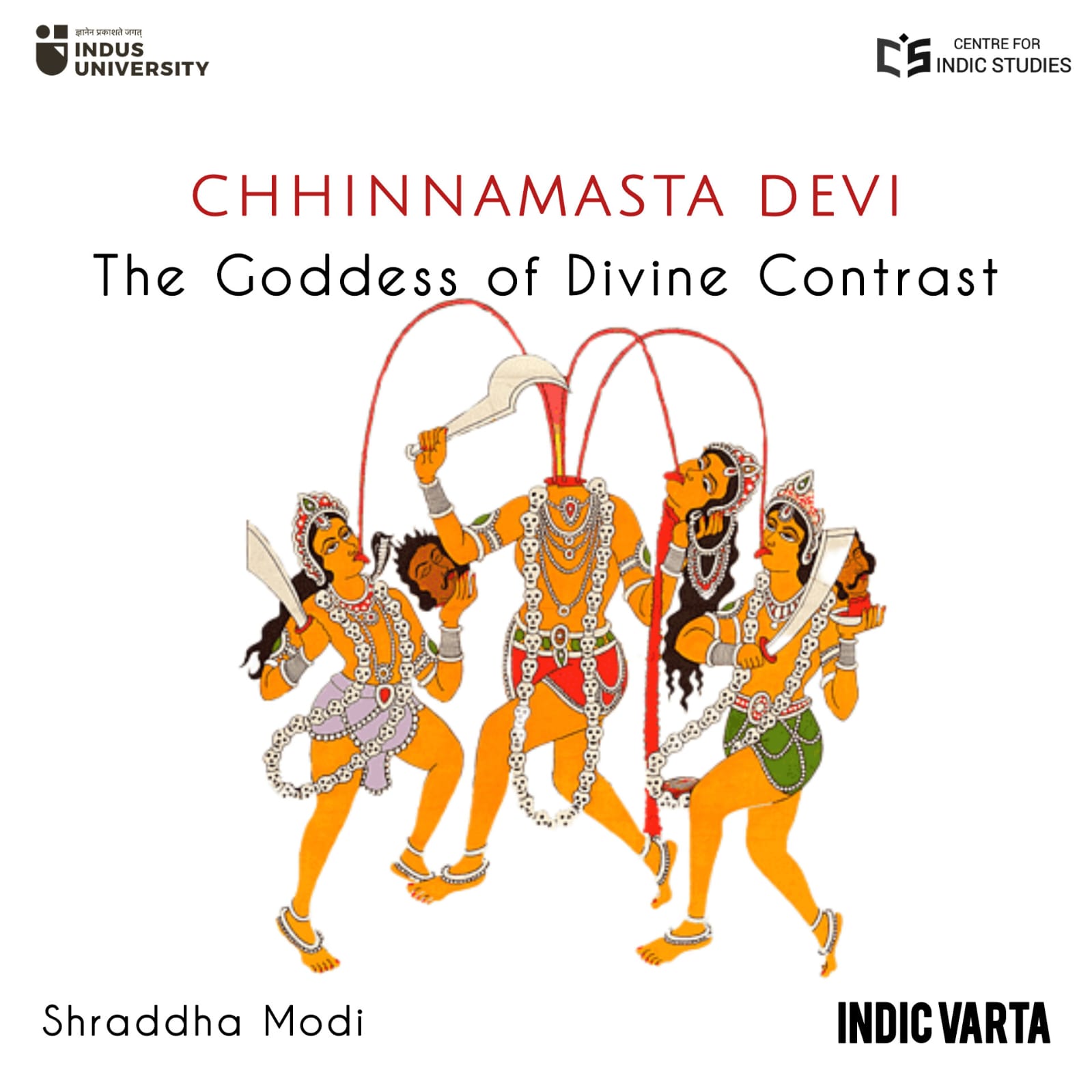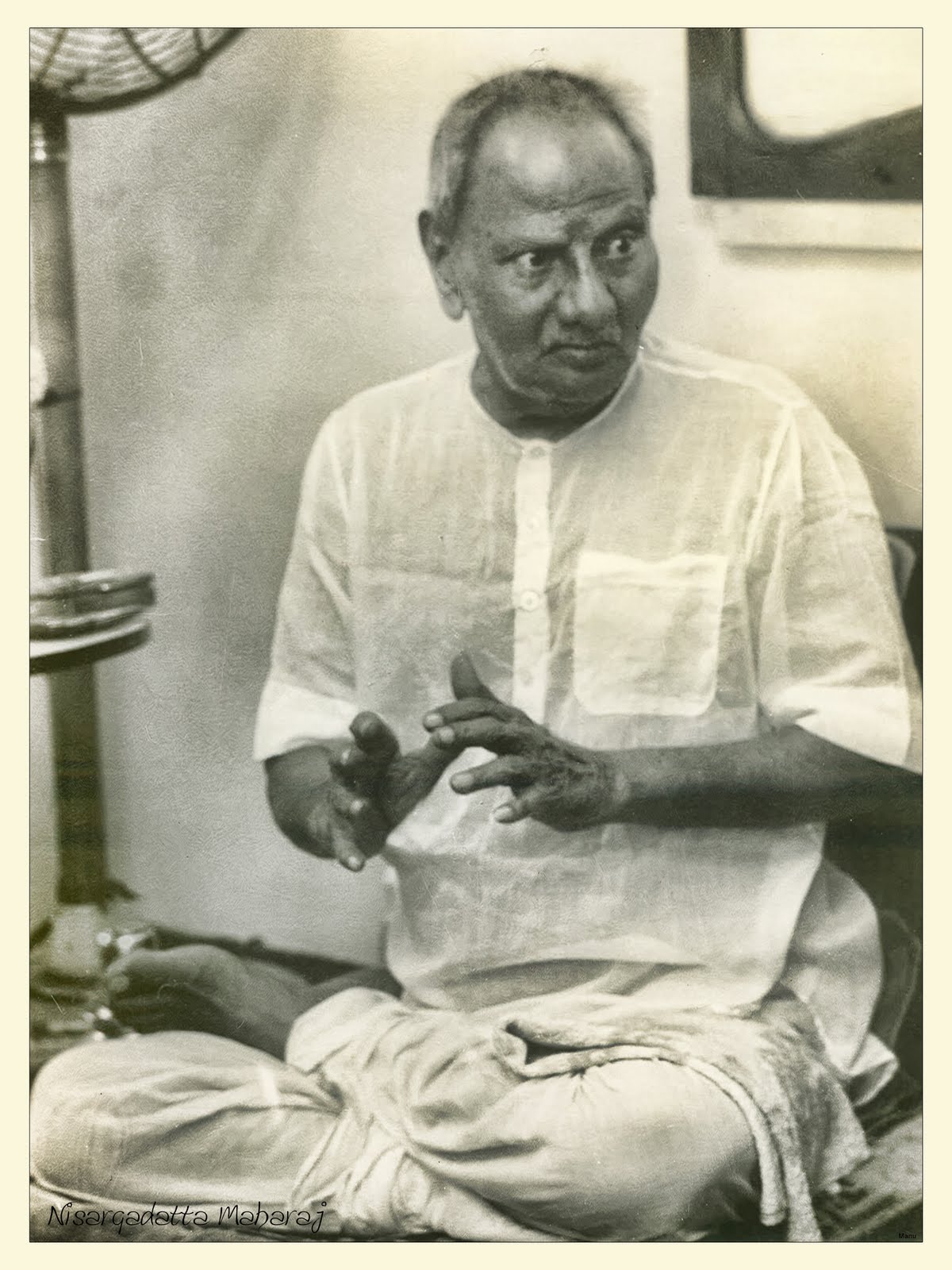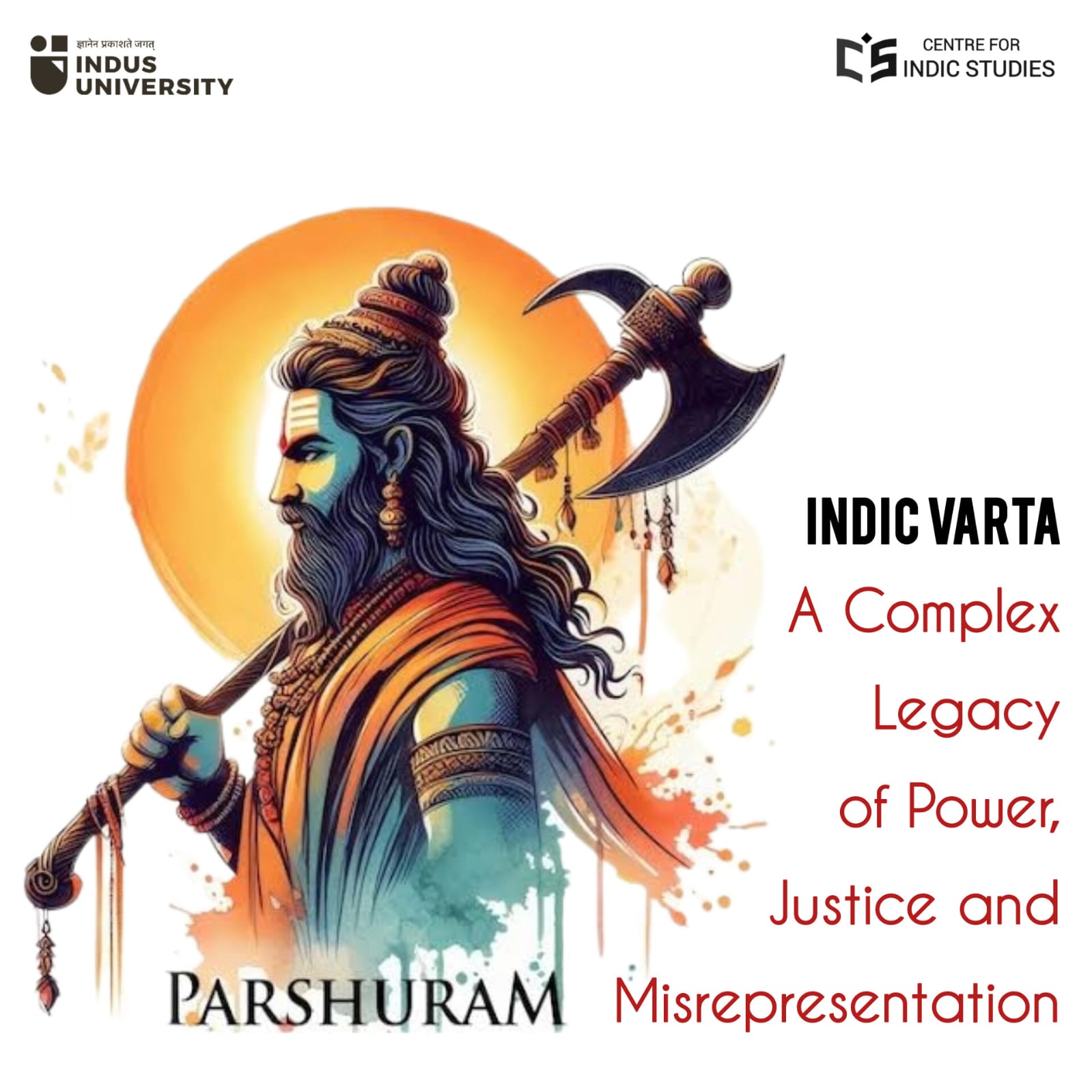- Visitor:195
- Published on: 2025-05-12
Chhinnamasta Devi: The Goddess of Divine Contrast
Across the traditions and cultures, Jogani mata and Chhinnamasta Devi both are the mirrored forms of fierce feminine. Chhinnamasta Devi belongs to the tantrika Mahavidya tradition and Jogani Mata belongs to Gujarat's folk belief system. They share the same core symbolism and theological principles. A critical analysis suggests that there has been a common thread which keeps both the deities bound together. Chhinamasta Devi is the cosmic version of Jogani Mata and Jogani Mata is the folk face of Chhinnamasta Devi. Not only their narratives and symbolism but also their way of worship and rituals too are peculiar and share the commonality up to a certain extent.

Hindu mythology breathes life into an endless cosmos of deities, each embodying the timeless truths and cosmic energies, bearing the pride of holding the tradition that speaks out loud about the divine and yet paradoxical personalities of some of the Hindu deities. A sixteen year old girl severing her head off to propagate life! Later, turns out to be one of the most celebrated goddesses of the Hindu mythology and folklore. Chhinnamasta Devi, a Hindu goddess popularly known as one of the ten Mahavidyas (ten forms of the goddess) of the tantrika tradition is known for her contradicting persona. She is believed to be the cosmic version of the goddess Jogani mata, a local deity of Gujarat, who is known for her bold, fierce and courageous acts of protecting her devotees in the time of adversaries even at the cost of her own life.
The age-old tradition of worshipping a head-less deity
Chhinnamasta Devi is considered as the manifestation of Goddess Kali. The literal meaning of her name is “one with a severed head”. Chhinnamasta Devi is a sixteen-year-old girl having a red hibiscus flower complexion whose full naked body is covered with a long garland made up of severed skulls and bones; her two hands holding her severed head and a scimitar in each, a long stretched out tongue drinking her own blood flowing from her headless trunk, ecstatically. She is rejoicing with her two attendants, both depicted as drinking the blood coming out of her trunk. The episode of her cutting her head herself has various mentions with minor changes pertaining to local traditions and beliefs. One of the most famous legends surrounding this episode is where she decapitates herself to satisfy the thirst and hunger of her two female attendants. This episode depicts the various reasons which compelled the goddess to take this step of self-decapitation, indicating victory over self, the impermanence of the body and the headless state as our ultimate reality in the form of consciousness.
As per this legend, one day when Parvati was returning from the river Mandakini after her bath, with her two attendants Jaya and Vijaya (sometimes referred to as Dakini and Varnini), her skin color turned black after the bath due to her sexual arousal. At the same time, her two attendants requested her to feed them something as they were hungry. Initially she asked them to wait for sometime until she reaches home and arranges something for their hunger, but the hungry attendants became restless and requested again and again with many pleasing words like, “Oh the merciful”, “Oh the giver of boons”, “Oh the fulfiller of boons” etc. Soon after that the Goddess beheads herself to satisfy the thirst and hunger of her attendants. Later, they return home after Parvati re-fixes her head.
Symbol behind her Image
Chhinnamasta devi has gained a lot of attention due to her ownership over the dual seemingly contradicting aspects of life. May it be life and death, terror and serenity, or violence and liberation. Each and every part of the narrative stands for a unique iconography. In all the different versions there are few things going common:
Self-decapitation: Chhinnamasta devi severes her head which can be interpreted in many ways but the most suitable interpretation can be cutting off the ego (ahamkara) and the total surrenderance to the divine consciousness. It can also signify the peak of self-sacrifice for the sake of devotees
The smiling severed head on the right hand: This depicts the joy of transcending the body, not feeling pain but happy about it. Her head is severed, blood is coming out of it, the head is drinking that blood yet is so blissful about it. This shows that there should be no pain in losing the body. It shows that the joy of consciousness is not restricted only to the body. So, the severed head is not symbolizing death but, in fact, it symbolizes the true meaning of life and hence it smiles in serenity.
The two attendants drinking the Devi’s blood: It can be interpreted as the normal females who can be magnified by power upon getting blessed by the Devi, who otherwise will not get the divine wisdom if they still remain entangled in the worldly subjects.
Blood streams going into the attendants: The blood jets are representing the life force which the Goddess is transferring from herself into the devotees which magnifies them in totality. This transfer of energy can transform the lives of devotees and help them overcome all the challenges and adversaries.
Nude body and the lotus: Chinnamasta’s nude boy signifies the spiritual awakening by focusing on Kundalini, the primal energy (Shakti) and not getting entangled by any other social or illusional obstructions.
Standing on a copulating couple: She is often portrayed as standing over a copulating couple and mostly they are Kama and Rati. This strongly signifies the importance of winning over the sensual desires and mastery over the bodily pleasure for commencing the tantrika journey. Since she is one of the deities connected to tantrika wisdom, it becomes a mandate to understand her features from the tantrika perspective.
Jogani Mata: The Folktale of Chhinnamasta Devi
The word “Jogani” is often understood in the context of “Yogini”-- a spiritual and mystical female deity from tantrika tradition. Jogani Mata is also referred to as one of the chief deities in ‘Mata ni Pachedi’, a local textile tradition in the interior parts of Gujarat depicting the faith of nomadic people for the Devi Puja. In ancient times when nomadic people, especially the “Vaghri” community, were restricted from entering the temples for worship, they started building shrines by the sides of roads and in their villages to worship their goddesses. Several other goddesses are also included in this tradition like Kali, Durga, Bahucharaji etc. This tribe plays a crucial role in protecting the pan Indian culturally & regionally significant tradition of the Devi-Pujan.Through this tradition they rejoice and cherish the age-old history of episodes where their Goddesses have always shown up in times of adversaries.
Episodes of Courage, Sacrifice and Protection
Jogani Mata is believed to be the earthbound face of Chhinamasta Devi. From the villages of Gujarat to the cosmic realms she is the goddess of both life and destruction. There are few episodes which sing the glory of Jogani Mata’s strength and evolve her as gramadevata (village guardian deity). As per a famous incident in the folk lore, once due to the absence of rains the land of Kathiawad in Saurashtra cracked with the scorching heat. A demon named Raktvarna emerged in the hot sands of desert and started killing the villagers for the sake of his own pleasure. As the days passed his barbaric power and brutality grew leaps and bounds. Nobody in the entire piece of landmass could even attempt to stop him. In such a helpless situation, the tormented villagers went to Jogani Mata’s shrine as a last resort. No sooner did the villagers surrender themselves, then a woman from the shrine emerged confidently in front of them against the demon Raktvarna. The demon laughed out loud on looking upon the lone woman challenging him. Jogani Mata at once took out the scimitar and sliced her head off. There came out three jets of blood out of her bleeding neck: one stream was being drunk by her own decapitated head that she held in her right hand and the other two which were being consumed by two of her attendants, Dakini and Varnini. The goddess’ blood magnified their power, shape and size. They tore the demon apart limb by limb and drank all his blood. After a long dry season the rain fell for the first time that night. Since then, Jogani Mata is worshipped as the vanquisher of the demon.
According to another famous folktale, once the interior parts of Gujarat got engulfed in the jaws of disease and death. No medication or no doctor was able to come up with a solution. People were dying out of one or the other disease or incidents. Villagers sought the refuge of Jogani’s Mata’s shrine, they prayed and a vibrant lady dressed in red elegant outfit appeared in front of the devotees standing in front of the mata’s shrine. She severed her head and placed it in front of the deity’s shrine. The jets of blood sprang out of her neck, two consumed by her two attendants and the other consumed by her own shrine. The devotees were wonderstruck and spellbound. Miraculously next morning onwards the unusual and harmful incidents stopped taking place in the village and the series of death traditions finally ended. People considered that vibrant lady as the incarnation of Jogani mata and since then Jogani mata was considered as the guardian deity of the village.
The shared symbolism of Jogani Mata and Chhinnamasta Devi
Across the traditions and cultures, Jogani mata and Chhinnamasta Devi both are the mirrored forms of fierce feminine. Chhinnamasta Devi belongs to the tantrika Mahavidya tradition and Jogani Mata belongs to Gujarat's folk belief system. They share the same core symbolism and theological principles. A critical analysis suggests that there has been a common thread which keeps both the deities bound together. Chhinamasta Devi is the cosmic version of Jogani Mata and Jogani Mata is the folk face of Chhinnamasta Devi. Not only their narratives and symbolism but also their way of worship and rituals too are peculiar and share the commonality up to a certain extent.
Worship Traditions across the cultures
Chhinnamasta Devi belongs to the Shakta tantra tradition and is considered as the sixth Mahavidya. As per the focal aspect of the Tantric tradition, the aim is to eradicate or master over ego, sensual pleasure and other worldly subjects to be in sync with the cosmic power. Hence the rituals for Chhinnamasta Devi are also related to these aspects. Her worship generally begins in the Vaishakh month and peaks during Chaitra Navratri. There are very few temples dedicated to her which includes her iconic headless shrine which is located in Jharkhand named Rajrappa temple. In her worship people generally prefer animal sacrifice (symbolic), offerings of red flowers and blood like substances, in the premises they often perform meditative practices for spiritual transformations. There are certain yantras also used by the experts during her Tantric worship along with the recitation of some mantras, generally such practices are observed in the isolated and secluded grounds of crematorium to embrace and cherish the mortality and impermanence of the human body which acts as the fulfilling element in the spiritual awakening. Just as the worship of Chhinnamasta Devi shakes the consciousness from inside out resulting in an awakening, similarly on the other side, the worship of Jogani mata is rooted in the daily life of the villagers and localities. Jogani mata is worshipped across the villages and interior parts of Gujarat like Saurashtra and Kutch. Specially the local tribes like Vaghari and Rabari are seen worshipping this deity wholeheartedly. For them, Jogani mata is their guardian and protector, their faith stands still throughout the centuries that their deity will protect them against all odds and adversaries. She is worshipped in a gala way, villagers gather near her temple and discuss the legends of Jogani Mata for the younger generations to know the history. Somewhere women are also found enacting the divine legends. Animals like goats and cocks are sacrificed to appease the deity. On that day women bring red cloth, sindoor [vermilion] and coconuts. The community also practices Mata-ni-Pachedi, a painting depicting the shrines and avatars of the deities showcasing the faith of the local tribes. Jogani mata is generally worshiped around trees and cremation grounds.
Conclusion
By studying the iconography, worship patterns, and the symbolization from a critical perspective, it becomes evident that both Chhinnamasta Devi and Jogani Mata are the deities evolving from different cosmic and religious traditions respectively but they both represent the fierce feminine divine strength. The narrative of their self-decapitation depicts the courageous step of self-sacrifice, transfer of power or life and true objective of the human body which is for the sake of others. Chhinnamasta Devi is always found satisfying and pacifying her attendants while Jogani mata is the gramadevata, the guardian of the villagers against all the adversaries, their existence differs on the parameter of time and space but their cosmic connection remains unchallenged. Not only they share the episodes but also the rituals and worship patterns; the devotees of Jogani Mata perform animal sacrifice and the tantrika initiates to perform animal sacrifice initially for Chhinamasta Devi. Both the deities are worshipped with red and vibrant substances like vermilion and red clothes etc. Chhinamasta Devi transcends her devotee on a spiritual level and Jogani mata transcends the situations of the people from weak to strong. Their severed head with smiling face inspires people to understand the impermanence of the mortal body and understand the presence of true bliss in the immortal consciousness and self sacrifice. On the occasion of Chhinnamasta Devi Jayanti one must understand the significance and symbolism, inculcating such values like self-sacrifice, serving the society and mastery over senses and worldly subjects to overcome sorrow. That will be the true reverence for Jogani mata, the folk-face of Chhinnamasta Devi and Chhinnamasta Devi who is the cosmic version of Jogani Mata.
References
Kinsley, David. Tantric Visions of the Divine Feminine: The Ten Mahāvidyās. University of California Press, 1997.
Frawley, David. Tantric Yoga and the Wisdom Goddesses: Spiritual Secrets of Ayurveda. Lotus Press, 1994.
Dinnell, Darry. "Can Tantra Make a Mātā Middle-Class?: Jogaṇī Mātā, a Uniquely Gujarati Chinnamastā." Religions, vol. 8, no. 8, 2017, p. 142. MDPI, https://doi.org/10.3390/rel8080142.
Image Courtesy
Chhinnamasta Devi: Historified Blog
https://historified.in/2024/06/04/chinnamasta-the-self-decapitated-goddess/
Mata ni Pachedi: Gaatha
https://shop.gaatha.com/painting-mata-ni-pachedi-jogani-maata
Jogani Mata Temple Image: Palodar, Mehsana, Gujarat
https://www.facebook.com/MehsanaCityOfficial/posts/%E0%AA%86%E0%AA%9C%E0
- 97 min read
- 1
- 0










